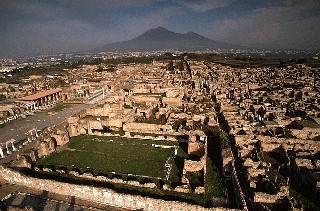Les Aventures Eoliennes

Pompei stands on a tray (about 30m above the sea level) formed by a stream of lava during a prehistoric Vesuvius eruption; it is furrowed by the Sarno, the stream that allowed the people access to the sea comfortably.
The origins of the city are uncertain. The oldest testimonies date between the end of the VII░ and the first half of the VI░ century BC., represented by the ancient stone walls called lava "pappamonte" and a group of houses.
It is under the influence of mixed civilizations: the Indigenous, Etruscan and Greek elements, that the city developed itself. Toward the end of the V░ century BC., the tribes of the Samnites, descended from mounts Irpinia and Samnium; they propagated themselves towards the actual plain of Campania (that means fertile plain), while conquering and inserting themselves in the cities of Vesuvius and the coast whose capital was Nuceria. Pompeii will stay under their influence for more than three centuries, until the conquest of Campania by the Romans.
In 80 BC., Pompeii becomes a Roman colony under the name of Cornelia Veneria Pompeianorum. It is enriched with private and public buildings, and is embellished thereafter once again, especially during the time of the emperor Octavian Augustus and Tiberius.
In 62 AD a violent earthquake shakes the whole Vesuvius region. In Pompeii the reconstruction begins immediately. Suddenly the eruption of the Vesuvio, on August 24, 79 AD, covered Pompeii with ashes. Most of its habitants perished while trying to escape or choked in their houses.
The rediscovery of this city took place in the XVI░ century during the construction of a channel that was to carry waters of the Sarno in Torre Annunziata, but only in 1748, under the reign of Charles III░ of Bourbon that the first excavations began.
It is in 1860, under the direction of Giuseppe Fiorelli that the systematic research was started. The restoration, the valorization of the ancient city and its heritage bring us exceptional architectures, sculptures, paintings and mosaics.Archaeological area of Pompeii extends about 66 hectares of which 45 have been searched. The archaeologists divided Pompeii in 9 regions.



.jpg)
